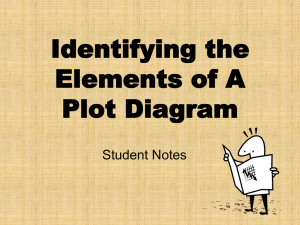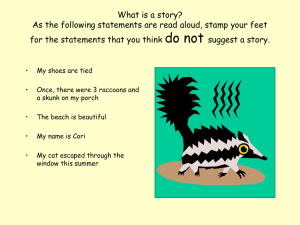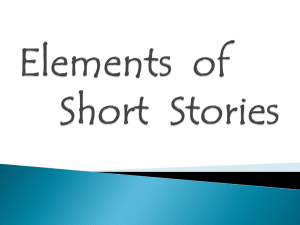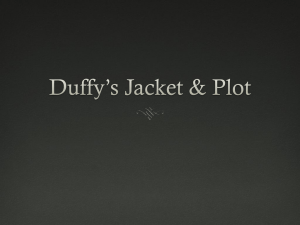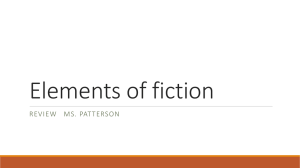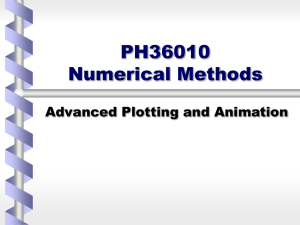Plot Elements: Structure, Conflict, Subplots, and Parallel Plots
advertisement
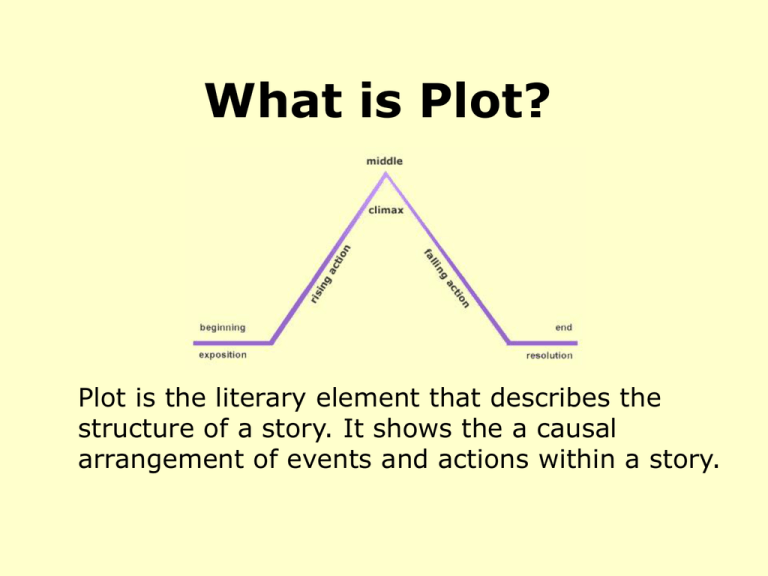
What is Plot? Plot is the literary element that describes the structure of a story. It shows the a causal arrangement of events and actions within a story. What are theTypes of Plots Plots can be told in Chronological order Flashback In media res (in the middle of things) when the story starts in the middle of the action without exposition What is Plot Structure? Freytag’s Pyramid is often modified so that it extends slightly before and after the primary rising and falling action. You might think of this part of the chart as similar to the warm-up and cool-down for the story. What are Plot Components? Climax: the turning point, the most intense moment—either mentally or in action Rising Action: the series of conflicts and crisis in the story that lead to the climax Falling Action: all of the action which follows the climax Exposition: the start of the story, the situation before the action starts Resolution: the conclusion, the tying together of all of the threads What is Conflict? Conflict is the dramatic struggle between two forces in a story. Without conflict, there is no plot. What are the Types of Conflict Person vs Person (often seen in the form of two characters against each other; it doesn’t have to be physical. It can be a battle between ideas). Person vs Nature External conflict (this can include weather, objects, activities … ) Person vs Society (main character(s) encounters struggle with the laws or beliefs of a group) Person vs Self (the struggle in one’s head) Internal conflict There are other types of conflict that I may also choose to cover with you in class. What are the minor types of conflict? • Person vs. technology (Protagonist battles against machines or other types of tech) Person vs. the supernatural (Protagonist battles against the unknown, like ghosts, devils, spirits, etc.) In the following sentences, I have given you some different types of situations. Identify the type of conflict in each situation: 1. "If student A and student B decide to fight over something, that could be described as a conflict between two...?" -- the answer would be a conflict between two people. Man vs Man 2. "If student A has problems getting to school during the winter because of the snowfall and icy conditions, this could be described as a conflict or struggle with...?" Man vs Nature 3. "If a person has problems finding a job because he/she does not have the education typically seen as necessary for getting a job, this could be seen as a conflict between this person and...?" Man vs Society 4. “A person has problems with his conscience because he/she is being pressured to treat another student poorly, but yet wants to remain popular with his/her friends. Man vs Self What is a SUBPLOT? A subplot is a secondary story line that is not equal in strength and intensity to the main plot. It must be relevant to the main plot. Subplots may: •create the feeling of more life-like main characters. •reflect and enhance the action of the main plot. •influence the direction of the main plot. •provide comic relief. Examples of subplots: 1. In the main plot of a romance, one or both of the main characters may resist commitment. Another couple in the story, perhaps friends, confidantes, or coworkers of the main characters, are also falling in love but having problems that show aspects of the love relationship the primary story line does not. The main characters, through their involvement with the other couple, may learn from what they see and come to realize their own love for each other should not be denied. (Examples are continued on next slide) Examples of subplots: 2. In a story of conflict between a parent and a child, subplots involving a neighbor or friend's child may give some perspective on the main plot. Another subplot might be a visit from a grandparent that casts the parent back into the child role, an experience that helps that parent recall what his own childhood was like and results in a better understanding of his own child's behavior. We’ve heard of Parallel Plots, BUT What is it anyway?? Parallel Plots: Plots in which each main character has a separate but related story line that merges in the end. Examples: •Murderer and Detective •Two family members with opposite goals or methods •Rivals for a job •Old enemies (parallel plots to be continued on next slide ….) Parallel Plots In the plot outline, main character 1 has the first section. The story then moves to main character 2 and alternates between the two characters until they come together in the end. Each main character and his or her plot receive equal time. Each segment of the story moves the plot forward in time. An occasional scene may overlap in time, but the general movement should be forward. In the parallel plot, the characters might start out together and separate to follow their own paths. Or they may not connect until the end. Their story lines are related and the climax occurs when the two come together at the end. (To be continued on the next slide) Parallel Plots OK – let’s take all of the information on Parallel Plots that you have learned about in the last two slides and try to put this in terms both you and I can understand. Have any of you ever seen the movie, “Crash”? In this movie there are many different characters and each of them has their own separate story. Throughout the movie, the story line of all characters is played out. You are thoroughly confused trying to keep up with each character and wondering how this all relates, and then,all of a sudden toward the end of the story, you start seeing how each of these characters come together at the end through one common factor. Will Smith’s movie, “Seven Pounds” was similar to “Crash.” And if you have never seen these movies, have you (shhh, I won’t tell) ever watched a Soap Opera on TV? Think about all the different characters, but somehow, many of them seem to have something in common with another character in the show. The events of their lives cross somewhere and at some time throughout the duration of the show. Yip, you got it ---- parallel plots. You have learned about PLOT (and the story-plot triangle and its components – exposition, rising action, climax, falling action, and resolution), about conflict, subplots, AND you have learned all about parallel plots. Now, I would like for you to turn to your partner and explain what each of these components are and where they occur in the story. I would also like for you to give an example – other than the ones I have used. Good luck and get started!!

